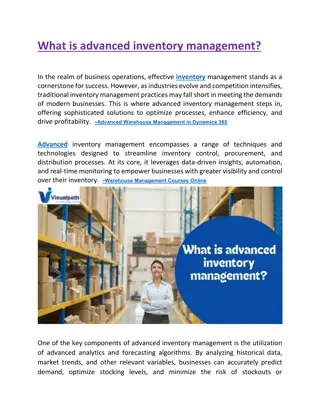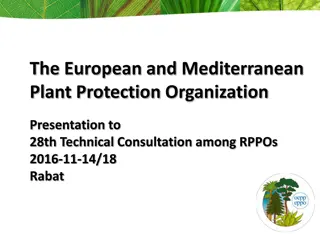Advanced Quality Engineering Course at Eastern Mediterranean University
The Advanced Quality Engineering course at Eastern Mediterranean University covers topics such as statistical process control, control charts, quality improvement, experimental design, acceptance sampling, and more. Students will explore various quality characteristics, CTQ parameters, and statistical techniques to enhance product quality. The course involves quizzes, homework, mid-term and final exams, with a focus on practical applications and software demonstrations.
Download Presentation

Please find below an Image/Link to download the presentation.
The content on the website is provided AS IS for your information and personal use only. It may not be sold, licensed, or shared on other websites without obtaining consent from the author.If you encounter any issues during the download, it is possible that the publisher has removed the file from their server.
You are allowed to download the files provided on this website for personal or commercial use, subject to the condition that they are used lawfully. All files are the property of their respective owners.
The content on the website is provided AS IS for your information and personal use only. It may not be sold, licensed, or shared on other websites without obtaining consent from the author.
E N D
Presentation Transcript
EASTERN MEDITERRANEAN UNIVERSITY DEPARTMENT OF INDUSTRIAL ENGINEERING IENG584 Advanced Quality Engineering SEMESTER / ACADEMIC YEAR COURSE CODE IENG584 Fall 2017-18 Advanced Quality Engineering COURSE TITLE CREDIT VALUE (3, 0, 0) 3 Asst. Prof. Dr. Sahand DANESHVAR Elective sahand.daneshvar@emu.edu.trIE- +90 392 630 2773 LECTURER(S) C109 COURSE TYPE PRE-REQUISITE(S) Consent of the instructor DURATION OFCOURSE 14 Weeks Monday 12:30-15:20 IE-E201 COURSE SCHEDULE COURSE WEB LINK http://ie.emu.edu.tr/lec/ann.php?lec=Sahand+DANESHVAR
Quizzes 5%+7%+10%=22 % Homework 6*3% =18 % Mid-term Exam 25% Final Exam TOTAL 35% 100 points TEXTBOOK/S Students must refer the following textbooks: Text Book: John Oakland, Statistical Process Control, 6th ed., Elsevier, 2008. Reference Books: Montgomery, D. C., Introduction to Statistical Quality Control, 6th ed., Wiley, 2009. Richard E. Devor, Tsong-how Chang, John W. Sutherland, Statistical Quality Design and Control, Prentice-Hall, 1992.
Week Topics 1 2 3 4 5 6 7 8 9 Review and preliminary subjects Control charts for ? , R Control charts for ?, S Control charts for fraction nonconforming p, np, c and u charts CUSUM charts and average run length Economic design of ? Charts Midterm Exam Quality improvement and total quality control Experimental and fractional factorial design The Taguchi method, off-line and on-line quality control, Parameter design Acceptance sampling, Producer s and Consumer s risks AQL, LTPO and AOQL systems Dodge-Romig System, Economic analysis of acceptance sampling Demonstration of software (SPSS, Minitab) Final Exam 10 11 12 13 14 15 16
Every product possesses a number of elements that jointly describe what the user or consumer thinks of as quality. These parameters are often called quality characteristics. Sometimes these are called critical-to-quality (CTQ) characteristics.
We focus on three major area: Statistical Process Control Control Charts Process Monitoring Technique Design of Experiment A designed experiment is an approach to systematically varying the controllable input factors in the process and determining the effect these factors have on the output product parameters. Statistically designed experiments are invaluable in reducing the variability in the quality characteristics and in determining the levels of the controllable variables that optimize process performance. Acceptance Sampling Acceptance sampling, defined as the inspection and classification of a sample of units selected at random from a larger batch or lot and the ultimate decision about disposition of the lot, usually occurs at two points: incoming raw materials or components, or final production.
The effective management of quality involves successful execution of three activities: quality planning, quality assurance, and quality control and improvement. Quality planning is a strategic activity, and it is just as vital to an organization s longterm business success as the product development plan, the financial plan, the marketing plan, and plans for the utilization of human resources. Quality assurance is the set of activities that ensures the quality levels of products and services are properly maintained and that supplier and customer quality issues are properly resolved. Quality control and improvement involve the set of activities used to ensure that the products and services meet requirements and are improved on a continuous basis.























